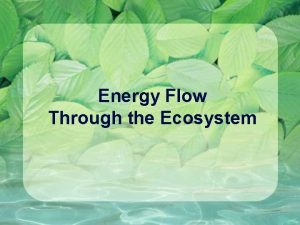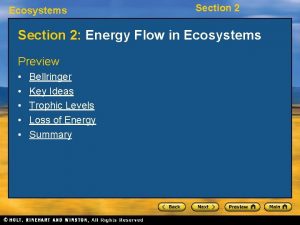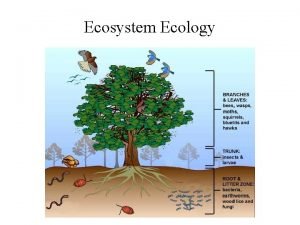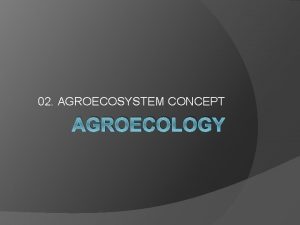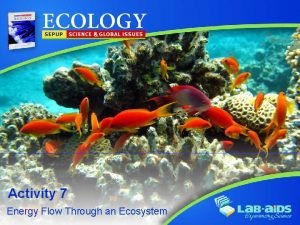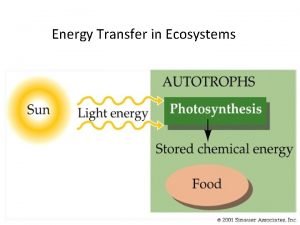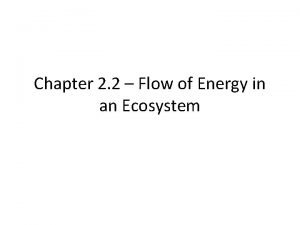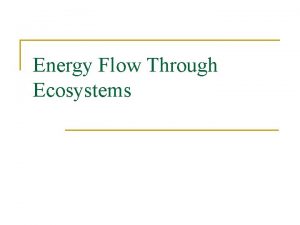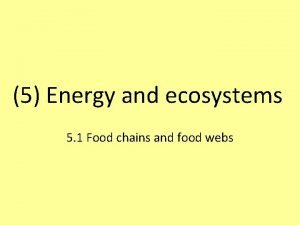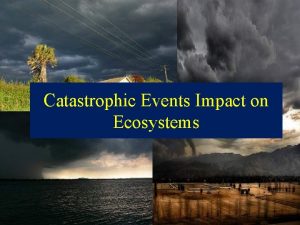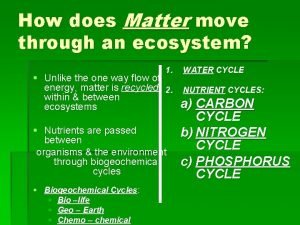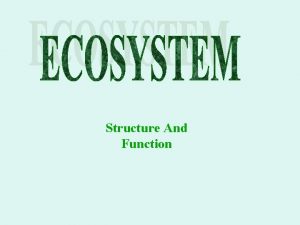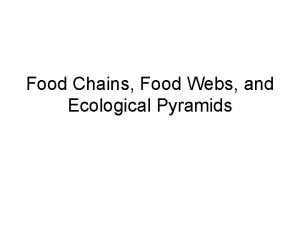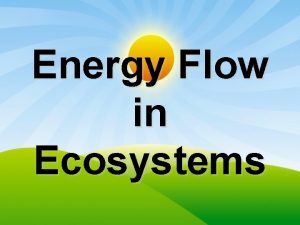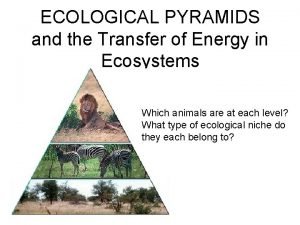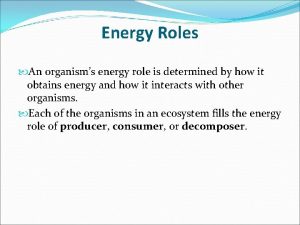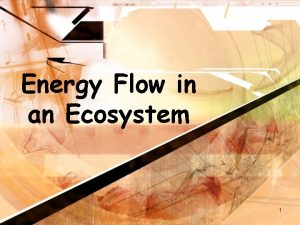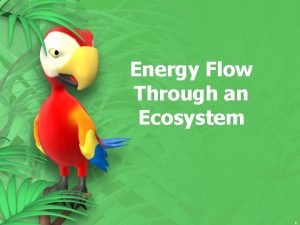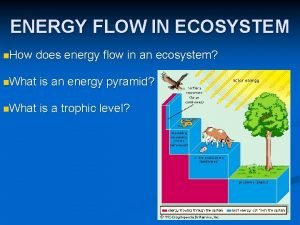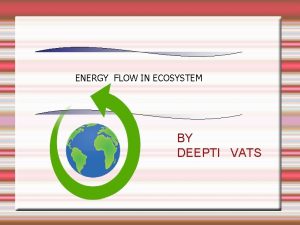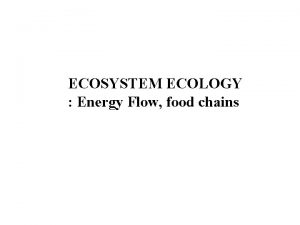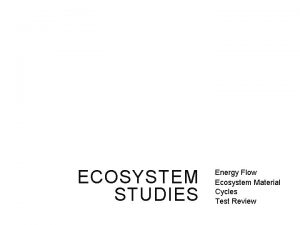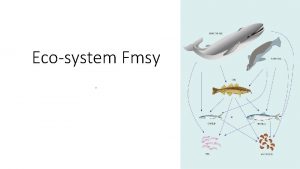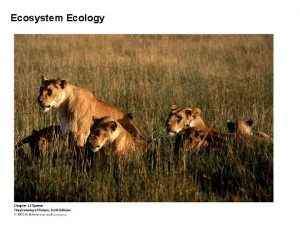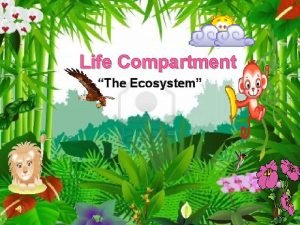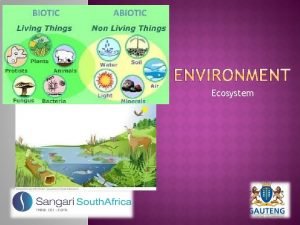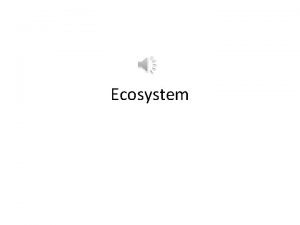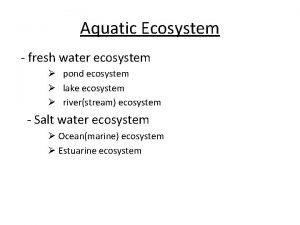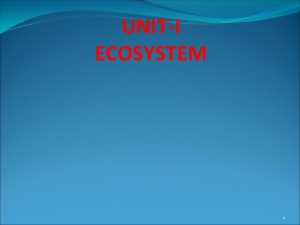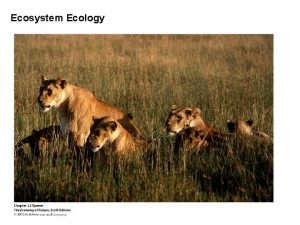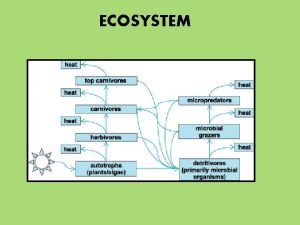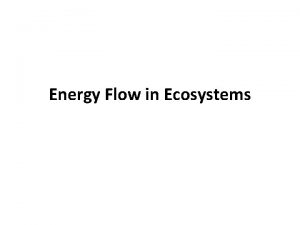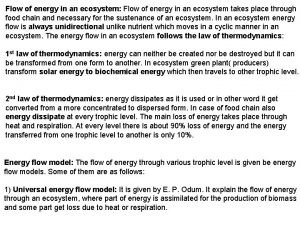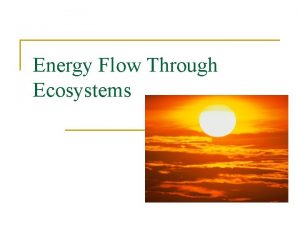ENERGY FLOW IN ECOSYSTEM n How does energy
























- Slides: 24

ENERGY FLOW IN ECOSYSTEM n. How does energy flow in an ecosystem? n. What is an energy pyramid? n. What is a trophic level?

ENERGY ENTERS ECOSYTEM n All energy in ecosystem comes from the sun n First law of Thermodynamics: Energy cannot be created or destroyed (but it can be transformed into stored energy & heat)

ENERGY LEAVES ECOSYSTEM n Second law of thermodynamics: Energy is lost as energy is transformed n In ecosystem, when energy is transformed, some energy is lost as HEAT

Only about 10% of the energy consumed by a first-level consumer is available for the second-level consumer. n The other 90% is used to support the life processes (keeping warm, pooping, etc) of the consumer n This means that the higher the level of consumer, the fewer there are of them because they have to eat A LOT to get enough energy n

ENERGY PATHS 3 ways to illustrate energy flow 2. Food Web: many paths 1. Food Chain: Single path 3. Food Pyramid

FOOD CHAINS n A food chain shows the path of energy from one organism to the next n energy flows from producers to consumers n arrows point to who is eating (plant is eaten by herbivore) n Usually decomposers are left out

FOOD WEBS n A food web shows all feeding relationships in an ecosystem (made of many food chains)

FOOD WEBS n Typically, food webs go like this: CONSUMER (OMNIVORE) CONSUMER (CARNIVORE) remember: decomposers receive energy from all other organisms in an ecosystem CONSUMER (HERBIVORE) DECOMPOSER PRODUCER

Types of Consumers 1. Herbivores – organisms that eat only plants (producers) • Example: cattle 2. Carnivores – organisms that eat only animals • Example: coyotes 3. Omnivores – organisms that eat both plants and animals • Example: bears, people

FOOD CHAINS AND WEBS n Practice! Draw a food chain that includes the following organisms: grasshopper n mouse n grass n owl n n Now label the organisms as producers, consumers (which type? ), or decomposers Tertiary CONSUMER (OMNIVORE) Secondary CONSUMER (OMNIVORE) Primary CONSUMER (HERBIVORE) PRODUCER

FOOD CHAINS/WEBS & ENERGY PYRAMIDS n Food chains/webs can be written as a pyramid: n Producers form the base of the pyramid n Consumers form the upper layers

What is an energy pyramid n An energy pyramid is a graphical model of energy flow in a community. The different levels represent different groups of organisms that might compose a food chain. From the bottom-up, they are as follows:

n Producers (autotrophs)— brings energy from nonliving sources into the community-makes own food n Primary consumers (heterotrophs)— eat the producers, which makes them herbivores in most communities-obtains food and energy by eating other organisms

n Secondary consumers (heterotrophs) — eat the primary consumers, which makes them carnivores and sometimes omnivores n Tertiary consumers (heterotrophs) — eat the secondary consumers

Which is both a first and second level consumer?

Energy Pyramid Tertiary Consumer Secondary Consumer Primary Consumer Producer

ENERGY PYRAMIDS The energy pyramid shows energy flow in an ecosystem: n n A level of the energy pyramid is called a TROPHIC LEVEL Each trophic level represents the energy for those organisms Top Consumer Energy stored by Secondary Consumers Energy stored by Primary Consumers ENERGY STORED BY PRODUCERS

TROPHIC LEVELS n Energy is lost with each trophic ~90% is released to the environment as heat by the organism n ~10% of the energy is used for the next level n Only about 10% of the energy from one level is passed on to the next level

What is a community? Communities are populations of organisms that interact with each other. n The interactions among different populations are what hold a community together. n A good example is a tree that houses birds, insects, and other creatures. n

Population includes all the members of a species found in a given area. n Your lawn has populations of dandelions, grasses, earthworms, and other living things. These populations together make up a lawn community. Lawn n Community earthworms dandelions grasses populations

THINK!!!! n Brainstorm jobs that people have in the community. n Discuss with your group how those jobs are important to the health of the community. n What would stop them from doing their jobs?

Niche n the role played by an organism in the natural world. n the way a species relates to, or fits in with, its environment. n Animals and plants all have very special roles to play in their communities. The niches they fill help keep their habitats healthy.

Niche n Some animals, like the pileated woodpecker, are insect eaters. They control insect populations in a community. He eats carpenter ants by chiseling them out of trees with its beak. Without animals like the woodpecker, insect populations could grow out of control.

DID YOU KNOW? ? . . . every organism in a community has a unique niche. n . . . one organism may have many niches in a community n
 How does energy flow through an ecosystem
How does energy flow through an ecosystem Nutrient chain foldable
Nutrient chain foldable How does energy flow through an ecosystem
How does energy flow through an ecosystem Section 2 flow of energy in an ecosystem
Section 2 flow of energy in an ecosystem Energy flow and material cycling in ecosystem
Energy flow and material cycling in ecosystem Energy flow and material cycling in ecosystem
Energy flow and material cycling in ecosystem Energy flow in ecosystem
Energy flow in ecosystem Describe the flow of energy in the kelp forest ecosystem.
Describe the flow of energy in the kelp forest ecosystem. Ecosystem energy transfer
Ecosystem energy transfer Principles of ecology 2 flow of energy in an ecosystem
Principles of ecology 2 flow of energy in an ecosystem Energy flow through an ecosystem
Energy flow through an ecosystem Sun grass grasshopper shrew owl
Sun grass grasshopper shrew owl Flow of energy vs flow of matter
Flow of energy vs flow of matter Oikos meaning
Oikos meaning What does conduction
What does conduction Energy transfers in food chains
Energy transfers in food chains How do tornadoes affect ecosystems
How do tornadoes affect ecosystems How does matter move
How does matter move Deseart
Deseart Biomass pyramid
Biomass pyramid Abiotic
Abiotic Detritus food chain
Detritus food chain Pyramid of number
Pyramid of number Pyramid of energy in ecosystem
Pyramid of energy in ecosystem An organism's energy role is determined by how it obtains
An organism's energy role is determined by how it obtains
